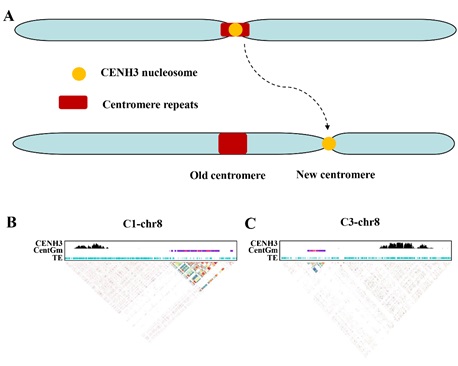In a study published in PNAS, Dr. HAN Fangpu’s research team from the Institute of Genetics and Developmental Biology of the Chinese Academy of Sciences has shed light on the fascinating world of soybean genome evolution.
The researchers studied the phenomenon of centromere repositioning, which involves the formation of new centromeres at different chromosomal locations without altering the underlying DNA sequences. This process has been widely observed in mammalian species and is thought to play a crucial role in genome evolution and speciation.
The researchers performed a comprehensive pan-centromere analysis using CENH3-ChIP-seq data obtained from 27 soybean accessions. This diverse set of accessions included three wild soybeans, nine landraces, and 15 cultivars. Building on the previous discovery of three centromere satellites in soybeans, they identified two additional centromere satellites that specifically associated with chromosome 1. These new satellites revealed significant rearrangements in the centromere structures of chromosome 1 across different accessions, affecting the localization of CENH3.
Furthermore, the researchers revealed a high frequency of centromere repositioning on 14 out of 20 chromosomes. Interestingly, many of these newly formed centromeres were found in close proximity to the native centromeres.
Additionally, some of these emerging centromeres were shared among distantly related accessions, suggesting that their emergence is independent of genetic relatedness.
To gain further insight, the researchers conducted hybridization experiments by crossing two accessions with mismatched centromeres. The results showed that a significant proportion of centromeres in the S9 generation underwent changes in both size and position compared to their parental counterparts. This highlighted the central role of centromere satellites in centromere organization, as they were found to be preferred sites for centromere localization, contributing to a stable state.
In summary, this groundbreaking research has unveiled the extensive phenomenon of centromere repositioning within the soybean genome. Moreover, it underscores the significance of centromere satellites in controlling centromere positions and supporting their critical functions.
These results mark a significant step forward in our understanding of soybean genome evolution and have far-reaching implications for the fields of genetics and developmental biology.
During the evolution of the soybean genome, widespread centromere relocation occurred. (Image by IGDB)
Contact:
Dr. HAN Fangpu
Institute of Genetics and Developmental Biology, Chinese Academy of Sciences
 During the evolution of the soybean genome, widespread centromere relocation occurred. (Image by IGDB)Contact:Dr. HAN FangpuInstitute of Genetics and Developmental Biology, Chinese Academy of SciencesEmail: fphan@genetics.ac.cn
During the evolution of the soybean genome, widespread centromere relocation occurred. (Image by IGDB)Contact:Dr. HAN FangpuInstitute of Genetics and Developmental Biology, Chinese Academy of SciencesEmail: fphan@genetics.ac.cn CAS
CAS
 中文
中文




.png)
